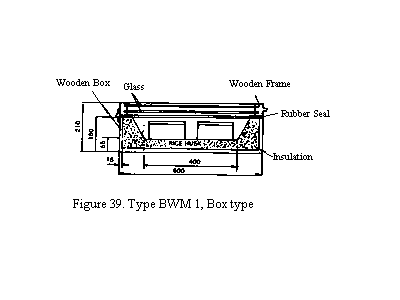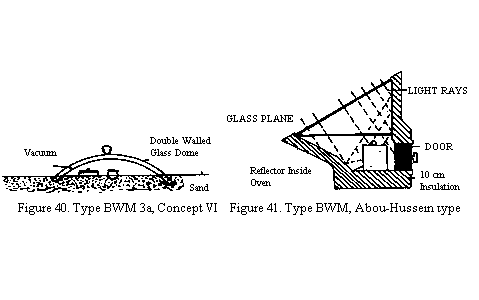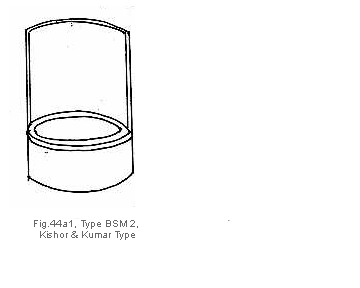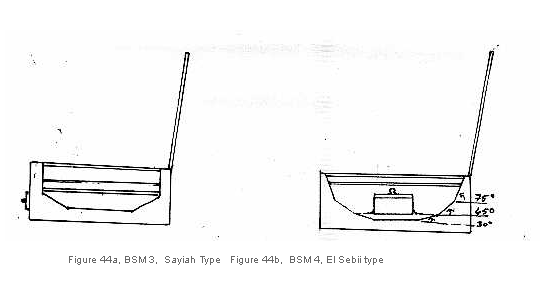
Box without reflectors/Box with reflectors/
Box without reflectors
Box-type cookers are very old and the most popular. The very first design of box-type cooker was that of Nicholas-de-Saussure (1740-1799). It was simply an insulated box with glazing; this forms the basis of all the present designs of box-type cookers including Warenham’s (1995) ‘Sunstove’ (Type BWM 1d). The cookers presented here are classified on the basis of reflectors, i.e., those without mirrors and those with mirrors. The cookers of the second category are further divided into five groups based on the number of reflectors as summarised in chart Ib.
WITHOUT
MIRRORS
WITH MIRRORS Single mirrors
Continued in next column |
Double
mirrors
Three mirrors
Four mirrors
Four plus four
|
Source:- TIDE., March 1998, 8-1, pp 1-37, For Comments, suggestions,contributions contact < ashok_kundapur@yahoo.com>
Nicholas-de-Saussure’s design (Type BWM 1, Figure 39) was the first to appear on the scene in the 18the century (Walton 1977). It was simply an insulated box with two glass panes forming the cover. Vaughen (1979) has recommended such a box with a slight difference. It is a typical box type meant for villagers. A rectangular pit is dug in the ground, suitably insulated with hay or rice husk, and a flat box not taller than 10 cm made of a metal sheet is fixed into this pit, and then covered with two glass panes with about 1-1 ½ cm space in between. Such a cooker would work well, at least during summer, in most parts of the country, but to increase the efficiency it would be essential to add a flat reflector. The author’s endeavours with solar cooking started with a similar design but the box constructed with mud, was above the ground. Round aluminium boxes painted with balckboard paint acted as cooking vessels. Results were good, though at times the rice cooked was rather bland.

Larger versions of such box-type cookers are being tried out successfully (Nahar et al. 1996; Singh 1993). The Chinese type (BWM 1b) and Brace Research Institute Designs, called food warmer (BWM 1c) (VITA 1961) appear to be similar designs. The food warmer, with better insulation and triple glazing, is still popular (Warenham 1995). Kumar, Kishore (1994) have made the box circular. Many other minor variations are reported, even for the cooking vessels, fixing knobs for the lid and ‘ears’ for the base, making the lid of the vessel concave (Arora, Sharma 1993). Some more design modifications will be discussed later in the text. The nineteenth century cooker of Herschel (Type BWM 2) was probably built on similar lines (Meinel, Meinel 1977). The box was buried in sand and covered with two glass panes, stagnation temperature of 116oC was reported. It is on record that certain nomadic groups of Saudi Arabia bury the food under the sand for cooking (BWM 3). The author feels that they could get their food cooked more reliably if they cover the area with a double glass dome (with the space in between vacuumed) with a knob for easier handling (Type BWM 3a, Concept VI, Figure 40). Rathinasamy et al., (Type BWM 3 b) have designed a rectangular box from sheet glass, (using popular silicon glue used to construct fish tanks) of 50 x 50 x 22 cm, and under this, the cooking vessels coated with suitable black paint are kept under a temperature of 1100C (Rathinasamy et al. 1988).
Abou-Hussein had presented another interesting variation. Here, the upper part of the box acts as a reflector (Type BWM 4, Figure 41). The window of the box which lets the light in is inclined at 450. The second glass pane is flat and there is ample space between the first and the second glass panes, and this space is used as a reflector. The design is attractive but costly (Bowman, Blatt 1978).

Source:- TIDE., March 1998, 8-1, pp 1-37, For Comments, suggestions,contributions contact < ashok_kundapur@yahoo.com>
In the box-type cooker, in most cases, the box is a double-walled container. Depth of the inner box should not be more than 10-15 cm. This depth is a critical parameter, whereas the width and breadth could be of any dimension. The space between these two boxes is filled with insulation, and, the width of the gap varies with the type of insulation used. It would be around 6-9 cm if rock wool is used; it could be a little thinner if fibre glass sheets are used. On the contrary, if low-grade insulation like straw or rice husk is used then the space would be more, about 10-15 cm. Composite insulation has also been suggested by many. In many cases the outer box will be of would and the inner box of sheet metal. In the design recommended by the Government of India, both the boxes are of 16 gz MS sheet. The shape is invariably rectangular or square, but the author has styled the box with slightly tapered base (Kundapur 1995)( Fig 41a ). Bowman suggested the use of foam glass (for box), a robust material which also acts as insulation for making the box, and recently, Warenham (1995) used styrofoam for making a lightweight box.
Several types of paints are suggested for the inner surface of the inner box to increase absorptive efficiency; blackboard paint was most popular. Yanthra Vidyalaya, Bardoli, recommends boiler interior paint, while Shanmugam et al. (1982) suggest special absorptive coating which would reduce cooking time by almost half. But if foam-glass is used there is no need for any paint. In some of the the designs, especially that of Musumdar’s the inner as well as the outer box are made of corrugated cardboard. Sharma, Philip (1992) also made a cardboard box cooker and used crumpled old paper for insulation.
Cooking has to be done in special vessels with tight-fitting lids. Round Hindalium boxes which are available easily in the market were found best but a knob has to be fixed for the lid and two ‘ears’ (handles) have to be fixed to the base such that the boxes could be easily handled. A good pair of tongs also becomes essential to handle the hot vessel; it could form a part of the solar box-type cookers and the manufacturer should be compelled to provide one good pair of tongs with fairly broad and flat gripping surface.
Most of the designs incorporate a double-glazed door on top of such an insulated box. Slight uneven surface between the upper part of the box and the door could be taken care of by strips of felt/cloth. The Government of India recommends toughened glass for the glazing, but the author found that the ordinary 3 mm glass also works well, however, it is safer to use toughened glass. The space between these two panes of glass is also critical, it should be just about 2 cm. Shanmugan et al. (1982) suggest the incorporation of a flat square steel sheet just below the second glazing, this sheet with special absorptive coating acts as a heat collector and transmits heat to the vessels kept just below it in the insulated box. The advantage of this design is that the cooking vessels may not require any coating. This is a plus point, for, in an ordinary box-type cooker the vessels are painted black, and the coating wears off on washing (Type BWM 5, Figure 42).Besides the vessels always look better without black paint on it. This is a very promising variation. Further, it may help to reduce the cost. Addition of one or two reflectors would indeed make this cooker very effective.

Source:- TIDE., March 1998, 8-1, pp 1-37, For Comments, suggestions,contributions contact < ashok_kundapur@yahoo.com>
Fatangare uses Fresnel lens in the lid of such a box ( Type BWM 7 ). Results are not known, but guess there will be too much of heat on top of the vessel
Reflectors were added to increase the efficiency, and hence, the reliability of the simple box-type cooker. There could be one to four or eight such reflectors. Further classification of these designs is based on the number of reflectors. The author’s earlier work had designated these as SM, DM, etc. but now a new code is used starting with ‘B’ for box-type cookers, and thus, BSM would designate box-type cooker with a single reflector.
Box with single reflector
Conceived by M K Gosh in 1945 (Gosh 1973), this cooker, known as the Gosh cooker, has become very popular all over the world. This design designated here as BSM 1 (Figure 43), was a typical box-type cooker with a double glazed cover (second cover) and a single reflector which doubles as another protective cover (first cover). The reflector could be held at a proper angle by a ‘kamani’ that is a bent iron rod with a slot in it, (popular in the market as a device to hold the steel window panes). Many found this rather cumbersome and even difficult. Pandya (1983) suggested a 2 cm iron flat with a couple of notches at the base. But the author feels that a longer iron flat of 2cm, with a couple of holes in it would be better. Such a bar can be fixed at a higher level on the reflector door for greater stability. Further , in many designs the peg to hold this bar is fixed on to the main box. But the author suggests that this peg should be on the second door/cover which has glazing, an arrangement which would render easier operation and handling of the cooking vessels (Figure 44).

The Gosh design has seen many variations and modifications, Hoda (1979), Garg (1978), Pandya (1983), and scientists of Bardoli (Parikh, Parikh 1976) have suggested several improvements (type BSM la, lb, lc,). Garg (Type BSM 1d) has fixed the glass door at 450 like that of Abou-Hussein design (BWM 4). Another improtant variation was the provision of two or three holes in the glazing for easier handling of the cooking vessel (Grupp et al, 1991). Concept VII proposed by the author is yet another variation mostly in design. The inner and outer boxes, made of 18 gx GI sheets are stylized, with 5 cm mineral wool insulation and double glazed second door and a reflector first door made of exterior quality 4 mm plywood. The reflector door was further strengthened with strips of wood on all sides and reinforced with aluminium beading. This design weighed only 14 kg as compared to the 25 kg standard design of the Government of India. Except for the aluminized polyester reflector attached to the door, the cooker lasted for several years. So, with a glass mirror reflector the cooker can be as good as any other box-type cooker.
Phillip et.al ( 1990 ) have published one of the best papers describing their attempt to reduce the weight but atthe sametime trying to maintain the efficiency. But as Bowman suggets to do this Foam Glass is the best alternative.
Encouraged by the performance and ease of the Gosh type of cooker, successful attempts have been made to build large cookers to cook up to 20-25 kg of food (Singh 1993); Nihar et al (1996). An electric booster has also been suggested (Arora, Sharma 1993).
Kishore and Kumar ( 1994) have presented an interesting variation, the box is round caan take only one cooking vessel and this has a small contorted reflector on one side. The reflector seems to have a fixed positon. Depending on the cost one can keep three or four such smaller cookers to cook various types of dishes. ( Fig 44 a1 )

Source:- TIDE., March 1998, 8-1, pp 1-37, For Comments, suggestions,contributions contact < ashok_kundapur@yahoo.com>
Prof.Sayigh et.al.,(1998 ) have comeout with a new design in which THREE glazing sheets are used, The 2nd and 3rd glazings are just above the cooking box while the first one is placed much above the 2nd. The gap has a reflective coating. The 3rd Glazing is 5 mm thick glass.The box has a drawer for cooking vessel, this reduces heat loss.The cooker has one reflector and hence has been classified here as BSM 3. Overall performance appears to be very good. The model is being popularised in Indonesia. ( Fig 44a )
Recently, El-Sebail (1994) proposed a new design which appears to be interesting. The box is with double glazing, and the interior has reflector surface set at different angles to focuss the sun light on the vessel The vessel is placed on the stand to meet the focus ( Fig 44b )

IMPORTANT NOTE
Regarding the insulated Box of Box type Gosh Solar Cookers, Prof. Barbera Kerr and several others had suggested using paper balls, straw and a wide variety of materials for making the box and the insulation to go inbetween. Inventors like Patel ( 1981, Ref. 74, ) had infact suggested inverted Glass Jar in-sted of a very heavy and combersome insulated Box. In fact this concept using glass jar around the pot could be traced back to Adam in 18th century. Later Prof. Bernard too suggested the use of such a Jar for his 'COOKIT' design. Gass Jars are costly and are prone for breakage so Prof. Barbera Kerr used clear plastic bags to cover the cooking pots very successfully. Prof. Bowman too had realised the importance of the insulation of Cooking vessel and he had suggested FOAM GLASS boxes around cooking pots for the FIT designs. Recently Deris uses two such clear jars ( Glass or heat resistant Polycarbonate jars ), inverted over the cooking pots where the light is concentrated by a circle of ordinary mirrors! I guess the solar Cooking can not be made simpler than this.
At this juncture I wish to introduce the work being pursued by Prof. David Delaney of Canada. Taking the cue from Prof. Bernard, and Barbera Kerr he is attempting to improve this Glass Jar concept. Covering the Cooking pot with a Glass jar has two problems, handling the cooking pot and its contents become difficult, and condensation of moisture inside the glass container affects the transmission of solar light to the pot. So he suggests use of a upright jar of not more than 2 inches in diameter of the cooking pot. Use of a suitable collar of card board or more stable material for placing the pot into the jar, and also a cooking pot with a clear glass 'insulated' lid. I feel that these suggestions are very apt, but at the sametime find that the Glass jars of that type are rather costly upto Rs. 400 ( $ 10 ) especially because Gosh type Solar Cookers of 2' x 2' were being sold in our country at Rs. 450 to 650! ( $ 12 to 16 only ). I do not suggest that the Box type of Cookers are better, but an attempt is needed to find a suitable material to cover the cooking pot.
Source:- TIDE., March 1998, 8-1, pp 1-37, For Comments, suggestions,contributions contact < ashok_kundapur@yahoo.com>
| PREVIOUS PART light from above | NEXT PART Indirect types |
For easy NAVIGATION use this chart.
OTHER LINKS are found under References S to W
click here for comments received
For Comments, suggestions,contributions contact < ashok_kundapur@yahoo.com>